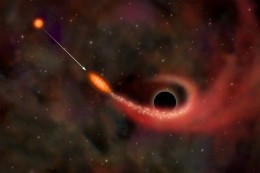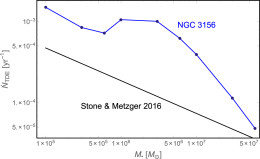Observed “burps” from the shredding of stars by supermassive black holes suggest that this behavior is more common in an unusual type of galaxy. A new study has examined NGC 3156, an example from this galaxy type, to better understand what causes this preference.
Stellar Betrayal

An artist’s illustration of a tidal disruption event, in which a star is sent on a plunging orbit near a supermassive black hole and is subsequently torn apart by the black hole’s tidal forces. [NASA/CXC/M.Weiss]
TDEs are triggered when a star is sent on a plunging orbit close to a supermassive black hole. But what sends the star into harm’s way? One possible culprit is a dynamical mechanism known as two-body relaxation. In this process, stars orbiting a black hole undergo individual star–star interactions that, with a close enough encounter, can send them on plunging orbits.
Choosing an Unusual Host
One puzzle with TDEs is that they tend to be preferentially found in rather unusual galaxies: galaxies that recently exhibited a lot of star formation but are now quiescent. In particular, several of the TDEs have been discovered in what are known as “E+A galaxies,” a rare subtype of elliptical galaxy that has recently undergone a major starburst.
Since this subtype makes up only ~0.1% of all galaxies, it’s surprising that we’ve found so many TDEs in E+A galaxies so far. So why the preference?
In an effort to answer this question, two scientists, Nicholas Stone (Einstein Fellow at Columbia University) and Sjoert van Velzen (Hubble Fellow at Johns Hopkins University), have teamed up to examine a nearby E+A galaxy, NGC 3156.

Tidal disruption rates as a function of central supermassive-black-hole mass. The blue curve shows the authors’ model for NGC 3156 (assuming different masses for its central black hole), and the black curve shows the power-law best fit for a large galaxy sample. NGC 3156’s predicted TDE rate is an order of magnitude higher that of a typical galaxy. [Stone & van Velzen 2016]
Collisions in a Crowded Nucleus
By analyzing Hubble Space Telescope photometry of NGC 3156, Stone and van Velzen determine that there is an overdensity of stars in the central region of the galaxy — which is expected to be the case for all E+A galaxies, due to their starburst history. The authors next use their measurements and arguments of stellar density and dynamics to calculate a predicted rate of two-body star–star interactions that lead to TDEs.
Stone and van Velzen predict that TDEs from two-body interactions should occur at a rate of ~10-3 per year in NGC 3156. This is an order of magnitude larger than the rate that the same calculations would predict for a typical galaxy (10-4 per year).
The authors’ observations and analysis of NGC 3156 strongly support the idea that E+A galaxies overproduce TDEs because their very dense centers — created by past starbursts — provide a highly collisional environment, allowing more star–star interactions. These interactions can then lead to stellar orbits that plunge near the supermassive black hole at the galactic center, producing TDEs.
Citation
Nicholas C. Stone and Sjoert van Velzen 2016 ApJ 825 L14. doi:10.3847/2041-8205/825/1/L14

1 Comment
Pingback: rare galaxy type has high incidence of SMBH disruptions of stars